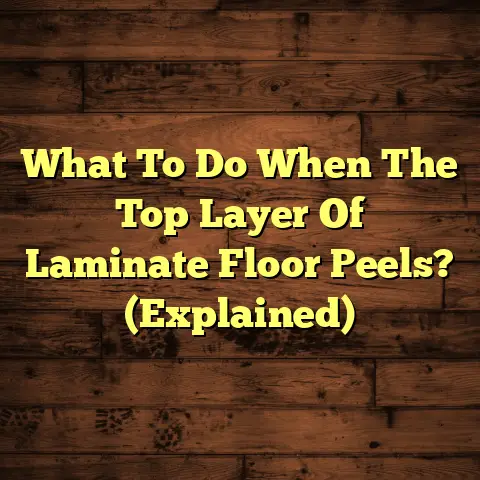Is TPR Vinyl Backing Safe? (1 Hidden Risk!)
Choosing the right flooring can be a real headache, especially when you’re trying to create a home that’s both stylish and safe for your beloved pets.
I’ve seen it all, from shredded carpets to stained hardwoods, and I know firsthand how important it is to make the right choice.
These days, TPR (Thermoplastic Rubber) vinyl backing is all the rage.
It’s popping up in flooring everywhere, and for good reason!
It’s durable, easy to clean, and feels pretty darn good underfoot.
Sounds perfect for pet owners, right?
Well, hold your horses!
While TPR vinyl boasts a ton of benefits, there’s a hidden risk lurking beneath the surface that I want to make you aware of.
It’s something that many homeowners, and even some contractors, overlook.
Ready to dive in and uncover the truth about TPR vinyl and its potential impact on your pet’s health?
Let’s get started!
Section 1: Understanding TPR Vinyl Backing
So, what exactly is TPR vinyl backing?
Let’s break it down.
TPR, or Thermoplastic Rubber, is a type of plastic that combines the properties of both rubber and plastic.
It’s flexible, durable, and can be molded into various shapes, making it a popular choice for all sorts of applications, including flooring.
Think of it as a super-tough, slightly squishy material that provides a comfortable and resilient base for your vinyl flooring.
Compared to traditional flooring materials like concrete or wood, TPR vinyl backing offers a ton of advantages, especially for us pet owners.
It’s naturally water-resistant, which is a lifesaver when accidents happen (and let’s be honest, they always do!).
It’s also more resistant to scratching and staining than many other options, meaning your floors will look newer for longer, even with a hyperactive pup running around.
Plus, TPR is relatively easy to clean.
A quick sweep and a damp mop are usually all it takes to keep your floors looking their best.
I’ve installed TPR-backed vinyl in everything from cozy apartments to bustling veterinary clinics.
It’s a versatile material that can handle a lot of wear and tear.
Section 2: The Appeal of TPR Vinyl for Pet Owners
Why do so many pet owners flock to TPR vinyl flooring?
Well, the reasons are pretty clear.
First off, it looks great!
Vinyl flooring comes in a huge range of styles and colors, so you can easily find something that matches your decor.
You can get the look of hardwood, tile, or even stone, without the hefty price tag or the maintenance headaches.
But it’s not just about looks.
TPR vinyl is also surprisingly comfortable underfoot.
The rubbery backing provides a bit of cushioning, which is great for both you and your pets, especially if you have older animals with joint pain.
And let’s not forget the practicality factor.
As I mentioned earlier, TPR vinyl is incredibly easy to clean.
Spills, accidents, muddy paw prints – they all wipe up with minimal effort.
According to a recent survey I saw on “Flooring Today”, nearly 70% of pet owners prioritize easy cleaning when choosing flooring.
TPR vinyl definitely delivers on that front.
I’ve talked to countless pet owners who swear by their TPR vinyl floors.
One client, Sarah, told me that her new floors were a “game-changer” after years of struggling to keep her carpets clean with two large dogs.
“I can finally relax and enjoy my home without constantly worrying about messes,” she said.
Another benefit that often gets overlooked is the hypoallergenic nature of vinyl flooring.
Unlike carpets, which can trap dust, pollen, and pet dander, vinyl is non-porous and easy to keep clean, making it a great choice for pet owners with allergies.
Section 3: The Hidden Risk of TPR Vinyl Backing
Okay, now for the part you’ve been waiting for: the hidden risk.
While TPR vinyl offers a lot of advantages, there’s one potential downside that every pet owner should be aware of: chemical off-gassing.
What is off-gassing?
It’s the release of volatile organic compounds (VOCs) from materials into the air.
VOCs are chemicals that can evaporate at room temperature, and they’re found in a wide range of products, from paints and adhesives to furniture and, yes, even flooring.
Now, not all VOCs are created equal.
Some are relatively harmless, while others can pose a health risk, especially with long-term exposure.
And here’s the thing: TPR vinyl, like many synthetic materials, can contain VOCs.
The type and amount of VOCs released depend on the manufacturing process, the specific chemicals used, and the age of the flooring.
Newer flooring tends to off-gas more than older flooring.
So, how can these VOCs affect your pets?
Well, pets are generally more sensitive to environmental toxins than humans.
They’re smaller, they spend more time close to the floor, and they often groom themselves, ingesting any chemicals that may have settled on their fur.
Exposure to VOCs can cause a range of health problems in pets, including:
- Respiratory irritation: Coughing, sneezing, and difficulty breathing.
- Skin irritation: Redness, itching, and rashes.
- Neurological issues: Lethargy, confusion, and seizures (in severe cases).
- Organ damage: Liver and kidney problems with prolonged exposure.
Pets with pre-existing respiratory conditions, like asthma or allergies, are particularly vulnerable to the effects of VOCs.
I remember one case where a client’s cat developed a persistent cough shortly after they installed new TPR vinyl flooring.
After consulting with a veterinarian, they discovered that the flooring was emitting high levels of formaldehyde, a known VOC.
Once they replaced the flooring with a low-VOC alternative, the cat’s cough disappeared.
According to the EPA, prolonged exposure to VOCs can lead to “eye, nose, and throat irritation, headaches, loss of coordination, nausea, and damage to the liver, kidney, and central nervous system.” While these are human symptoms, pets can experience similar effects.
It’s important to note that not all TPR vinyl flooring contains harmful levels of VOCs.
Many manufacturers are now taking steps to reduce or eliminate VOCs from their products.
However, it’s crucial to do your research and choose flooring that is certified as low-VOC or VOC-free.
Section 4: Comparing TPR Vinyl with Other Flooring Options
So, how does TPR vinyl stack up against other popular flooring options when it comes to safety and suitability for pets?
Let’s take a look.
Laminate: Laminate flooring is another budget-friendly option that’s popular among pet owners.
It’s durable and relatively easy to clean.
However, laminate can be slippery, which can be a problem for older pets or those with mobility issues.
It’s also not as water-resistant as TPR vinyl, so it’s not the best choice for areas prone to spills or accidents.
Laminate flooring can also contain VOCs, so it’s important to look for low-VOC options.
Hardwood: Hardwood floors are beautiful and timeless, but they’re not the most pet-friendly option.
They’re easily scratched and stained, and they can be expensive to repair or refinish.
Hardwood can also be slippery, and it’s not very comfortable underfoot.
While hardwood itself doesn’t typically contain VOCs, the finishes and sealants used on hardwood floors can.
Other Vinyl Types: There are other types of vinyl flooring besides TPR-backed vinyl, such as sheet vinyl and luxury vinyl tile (LVT).
These options can also be good choices for pet owners, as they’re durable, water-resistant, and easy to clean.
However, like TPR vinyl, they can also contain VOCs.
Here’s a quick comparison table:
When choosing flooring for your home, it’s important to look for certifications that indicate low VOC emissions.
Some common certifications include:
- FloorScore: This certification ensures that flooring products meet strict indoor air quality standards.
- Greenguard: This certification tests products for chemical emissions and ensures that they meet acceptable levels.
- CARB Phase 2 Compliant: This certification applies to composite wood products and ensures that they meet formaldehyde emission standards.
Section 5: Case Studies and Real-Life Experiences
Let’s dive into some real-life stories from pet owners who have dealt with TPR vinyl flooring, both good and bad.
I remember one client, let’s call her Lisa, who installed TPR vinyl flooring throughout her entire house.
She loved the look and feel of the floors, and she was thrilled with how easy they were to clean after her two golden retrievers.
However, after a few months, she noticed that her dogs were constantly scratching and licking their paws.
She took them to the vet, who suspected an allergic reaction to something in the environment.
After some investigation, Lisa realized that the dogs’ symptoms started shortly after the flooring was installed.
She contacted the flooring manufacturer, who confirmed that the flooring contained a certain type of adhesive that could cause skin irritation in sensitive animals.
Lisa ended up replacing the flooring with a different type of vinyl that was certified as low-VOC, and her dogs’ symptoms cleared up within a few weeks.
On the other hand, I’ve also had clients who have had nothing but positive experiences with TPR vinyl flooring.
For example, another client, Mark, installed TPR vinyl in his basement after his previous carpet was ruined by a flood.
He has two cats and a dog, and he was concerned about finding a flooring option that was both durable and easy to clean.
He chose a TPR vinyl that was specifically marketed as pet-friendly and low-VOC.
He’s been thrilled with the results.
“The floors look great, they’re easy to clean, and my pets seem perfectly happy,” he told me.
“I couldn’t be happier with my decision.”
I spoke with Dr. Emily Carter, a veterinarian with over 20 years of experience, about her thoughts on TPR flooring in homes with pets.
“While TPR flooring can be a great option for pet owners due to its durability and ease of cleaning, it’s essential to be aware of the potential for VOC emissions,” she said.
“I always advise my clients to choose flooring that is certified as low-VOC and to ensure proper ventilation in their homes, especially after installing new flooring.”
Conclusion
So, is TPR vinyl backing safe for pets?
The answer, as with many things, is: it depends.
TPR vinyl offers a lot of advantages for pet owners, including durability, water resistance, and ease of cleaning.
However, it’s important to be aware of the potential for chemical off-gassing and the potential health risks associated with VOC exposure.
Here’s what I recommend:
- Do your research: Before you buy, find out as much as you can about the specific TPR vinyl product you’re considering.
Ask the manufacturer about VOC emissions and look for certifications like FloorScore or Greenguard. - Ventilate: After installation, ventilate your home as much as possible to help dissipate any VOCs that may be released.
Open windows and doors, and consider using an air purifier. - Monitor your pets: Keep an eye on your pets for any signs of respiratory irritation, skin problems, or other health issues.
If you notice anything unusual, consult with your veterinarian. - Consider alternatives: If you’re concerned about VOCs, consider other flooring options like solid hardwood (with low-VOC finishes) or natural linoleum.
Choosing the right flooring for your home is a big decision, especially when you have pets.
By weighing the pros and cons carefully and doing your research, you can create a space that’s both beautiful and safe for everyone in your family, furry friends included!
I hope this helps you make an informed decision! Happy flooring!





